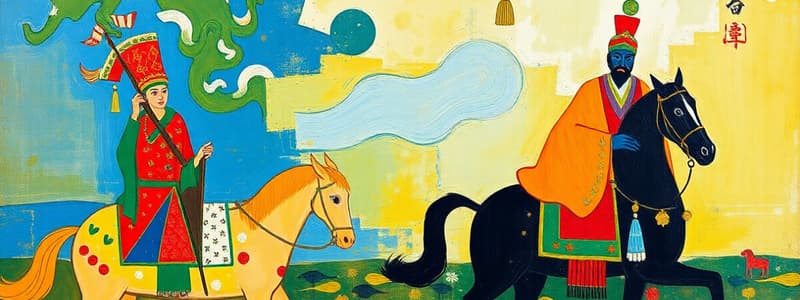Podcast
Questions and Answers
Which of the following best describes the strategic significance of the Fatimid dynasty's foundation of Cairo?
Which of the following best describes the strategic significance of the Fatimid dynasty's foundation of Cairo?
- It served primarily as a religious center, promoting only theological studies.
- It became a major political, economic, and cultural center, enhancing the dynasty's influence. (correct)
- It was designed as a retreat for the rulers, far from the political affairs of the time.
- It was intended to be a military outpost solely for defense against European crusaders.
The Tang and Song dynasties in China are notable for their advancements exclusively in the fine arts, with minimal impact on technological or agricultural innovations.
The Tang and Song dynasties in China are notable for their advancements exclusively in the fine arts, with minimal impact on technological or agricultural innovations.
False (B)
Explain how the Mongol Empire facilitated cultural exchange across Eurasia.
Explain how the Mongol Empire facilitated cultural exchange across Eurasia.
The Mongol Empire facilitated cultural exchange through secure trade routes, the movement of scholars and artisans, and the administration of diverse regions under a unified law, promoting interaction and diffusion of ideas and technologies.
The Mongol Empire, known for its vast territorial control, was established in the ______ century, significantly impacting trade and cultural exchange across Eurasia.
The Mongol Empire, known for its vast territorial control, was established in the ______ century, significantly impacting trade and cultural exchange across Eurasia.
Match the following aspects of society with the Chinese dynasty most closely associated with its growth:
Match the following aspects of society with the Chinese dynasty most closely associated with its growth:
Which factor most contributed to the military successes of the Mongol Empire under leaders like Genghis Khan?
Which factor most contributed to the military successes of the Mongol Empire under leaders like Genghis Khan?
Japanese civilization during the period covered remained static, resisting any significant cultural influences from mainland Asia.
Japanese civilization during the period covered remained static, resisting any significant cultural influences from mainland Asia.
What were the key factors that led to the decline of the Fatimid dynasty in North Africa and Egypt?
What were the key factors that led to the decline of the Fatimid dynasty in North Africa and Egypt?
The ______ system, adopted during the Tang Dynasty, selected officials based on merit rather than noble birth, promoting a more efficient and fair government.
The ______ system, adopted during the Tang Dynasty, selected officials based on merit rather than noble birth, promoting a more efficient and fair government.
How did the geography of Japan influence its early development and culture?
How did the geography of Japan influence its early development and culture?
Flashcards
Fatimid Dynasty
Fatimid Dynasty
A dynasty that ruled parts of North Africa, Egypt, and Syria from the 10th to 12th centuries, known for its cultural and religious influence.
Tang and Song China
Tang and Song China
The dynasty oversaw significant advancements in technology, trade, and culture, including the invention of gunpowder and the compass.
The Mongol Empire
The Mongol Empire
Vast empire established by Genghis Khan and his successors in the 13th and 14th centuries, uniting various Eurasian territories.
Japanese Civilizations
Japanese Civilizations
Signup and view all the flashcards
Exam Question Types
Exam Question Types
Signup and view all the flashcards
Document-Based Question (DBQ)
Document-Based Question (DBQ)
Signup and view all the flashcards
Study Notes
- The Grade 7, Quarter 3 exam will cover the Fatimid Dynasty and the foundation of Cairo, Tang and Song China, the Mongol Empire, and Japanese civilizations.
- Textbook review should include side notes, terms and names, vocabulary, maps, and assessment questions at the end of each lesson.
- Emphasis should be placed on studying the map of the Mongol Empire.
- Review lesson notes, FCs (likely Foldables or Fact Cards), CWs (Class Work), ETs ( احتمالا Extra Tasks or Enrichment Tasks), and in-class quizzes.
- The exam includes Multiple Choice Questions, Completion, True/False, Geography Skills, Short Answer Questions, and a Document-Based Question (DBQ) which is a reading comprehension passage with an unseen text related to the quarter's topics.
- All ideas included in the extra practice sheets are relevant for the exam.
- Primary source documents will not be included on the exam.
Studying That Suits You
Use AI to generate personalized quizzes and flashcards to suit your learning preferences.




